Montour Railroad
Mileposts
Bridges
and Tunnels
History
Maps
Roster
Mines
Links
Gallery
Working on the
Montour
Schaeffer
Stories
Sposato
Stories
Employees
Railroading
101

|
|
| Working
on the Montour |
|
| This selection
of photos and stories tell of some of the life of those who worked the
Mighty Montour. |
|
|
|
| 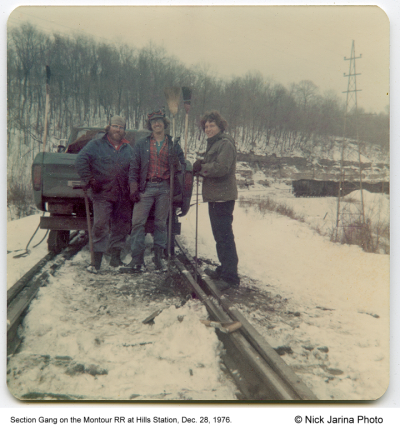 Handwritten on the back of this Nick Jarina photo... Handwritten on the back of this Nick Jarina photo...
Section Gang on the Montour RR at Hills Station, Dec. 28, 1976.Man in middle name is Tim. Tipple off on right.
After
seeing this picture it came back to me that we were repairing the
switch after a loaded hopper had “split “ the points. Several notes of
interest can be seen in this photo. If you zoom in on the loaded
hopper, just in front of it is a short phone pole stump next to the
main track, that is where the W.E. Hills phone booth was located before
it’s move to the #4 Supply yard. The tie down holes in the rear bed
corners of RH2 was were the switch brooms were “holstered’ while
working or cleaning snow.
The electric pole to the left of the
truck was for the power lines to energize the circuitry to operate the
two switch position indicator signals west of the loaded yard switch in
Kamps Cut. On the loaded yard side, PCCo. transmission tower, this is
one that branched off main transmission line for the #4 supply
yard usage. Big rail in the switch and main through there, 131 RE, if I
recall correctly, used rail from the P&LE. Foreman Schmidt was
wearing his traditional helmet liner hood that he wore all winter. He
is holding a spike maul.
Bobby Dengler with his frizzy ‘Fro”
look, rarely wore a hat, regardless of weather it seemed and
always with the Army coat. He was working the long wrench to tighten
the new bolts that we installed. I am wearing my striped RR
cap as usual, also this photo caught me at my newly
promoted position, burner/welder. I had cut off the derailment damaged
joint bar bolts and was now holding a claw bar (spike puller).
Note the goggles on my head and the torch hose to the left of the
truck. I was still taking night courses for welding, thanks to the
MRR/P&LE, meanwhile John rattled management to pay me a higher
rate, so I took over the welding job that John used to have before his
promotion to Section Foreman. Oh did I mention, it was winter, snowy
and cold…..Amazing how many thoughts can be regenerated by looking at
one picture. Thanks Nick! - Tim Sposato. |
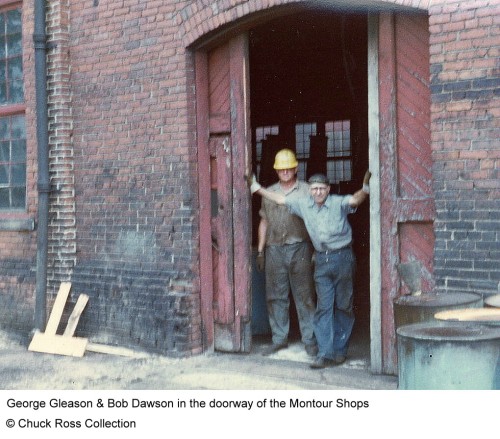
|
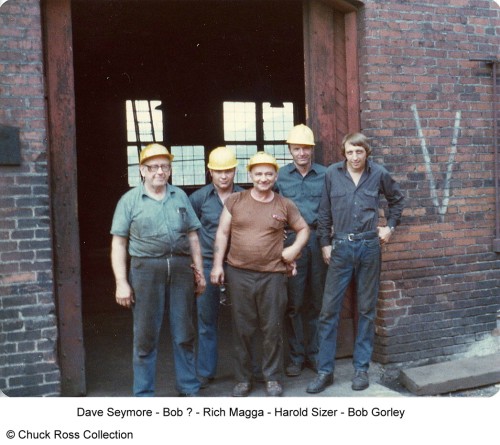 Great
to see Dave Seymore, Rich Maga and Harold Sizer and George Gleason. Great
to see Dave Seymore, Rich Maga and Harold Sizer and George Gleason.
When working as Train Dispatcher I usually seen each of these guys
daily.
Dave always had a cigar clenched in his teeth. I believe Dave was the
Locomotive Inspector (?) When I talked with Rich (nickname "zing"), on
many occasions I joked about giving the SW-9's a bath and a wax job. (I
guess that's how they figured who was doing some cleaning of the
numbers and lettering).
On page 128 in the book, it was Dave, Rich and Hostler Vince Shulin
(not pictured) I was writing about. Hood doors on the SW-9's were
opened as they guys gave them a detailed visual inspection every day.
If a problem was discovered, that locomotive was switched out of the
consist and put into the shop.
Harold was Pipefitter and was often called out when you had to couple
or uncouple "M-U'ed" locomotives. Union rules...
George Gleason, worked in the Car Shops. He went to Champion and worked
as daylight car inspector, their office was the former B&LE
caboose that sat on the shove-up. I first met George in Mifflin
Junction about 1973. All of those hoppers off the Union for the Montour
needed inspected before Montour crews received them. George loved his
O.T... And would come out most any time you called him.
CAR - that 76 was sparkling in those photos. The 76 was one of the
SW-9's that I started washing during those summer Saturday afternoons
when the railroad was idle and I had nothing to do in the office,
probably 78 or 79. I guess cleaning off all of the grime from the side
of the cab of the 76, revealing that brilliant blue paint, the
outstanding logo and its number caught someone's attention and I heard
about it...
JES mumbled something about the Union and time slips... And if I knew
anything about this, it needs to stop...... Another one of his 5 or 6
AM talks with me.... In the car shops...look at all of those
PRR/PC hoppers...
- Gene P. Schaeffer
|
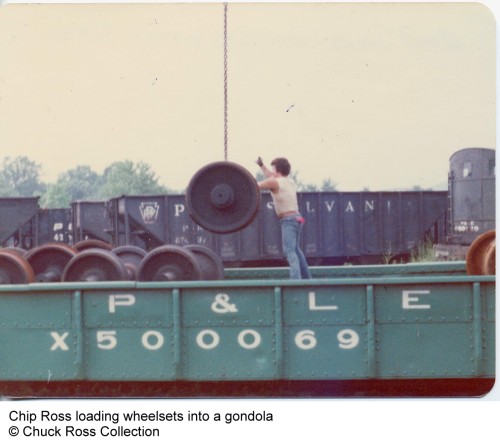 This
one shows Chuck's son Chip loading wheelsets into a gondola. Notice the
crane in the right background - It is not the X 1. This one has
different ladder & windows and is lettered for P&LE. X
1 could be the one lifting the wheelset This
one shows Chuck's son Chip loading wheelsets into a gondola. Notice the
crane in the right background - It is not the X 1. This one has
different ladder & windows and is lettered for P&LE. X
1 could be the one lifting the wheelset
|
|
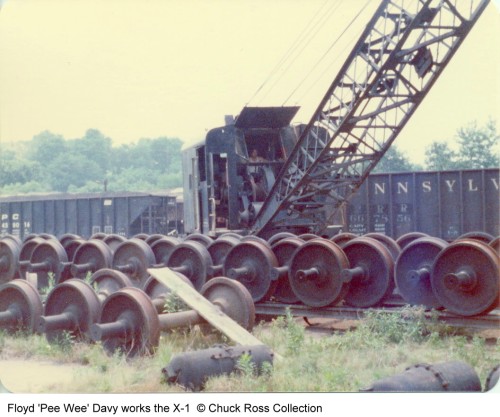 Floyd 'Pee Wee' Davy
Crane Operator (Car Shops) at Montour Junction. Floyd was crane
operator during my years with the Montour RR.
Floyd 'Pee Wee' Davy
Crane Operator (Car Shops) at Montour Junction. Floyd was crane
operator during my years with the Montour RR.
Floyd, when not running the X1, worked in the Montour Junction Car
Shops as well as car inspector Champion. (Union Senority)
Gene P. Schaeffer |
|
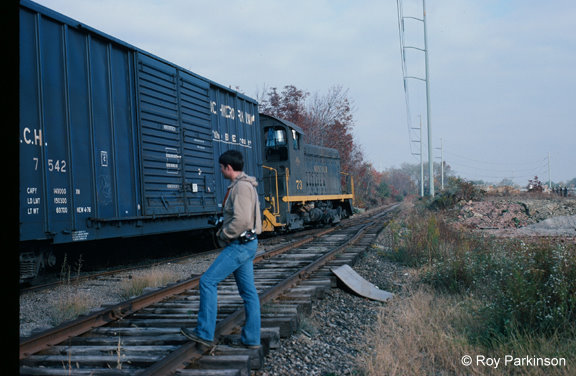
A photo of Gene P. Schaeffer taken at Brookside
Lumber in October 1980 by Roy Parkinson.
I had acquired
two new Canon camera's, one for black & white film and the
other for Kodachrome color slide film and had given Roy my Mamiya/Sekor
35mm camera to use. I believe R.J. is running the 73. - Gene
P. Schaeffer
Photos below
are provided by George DeVault. Thanks George.
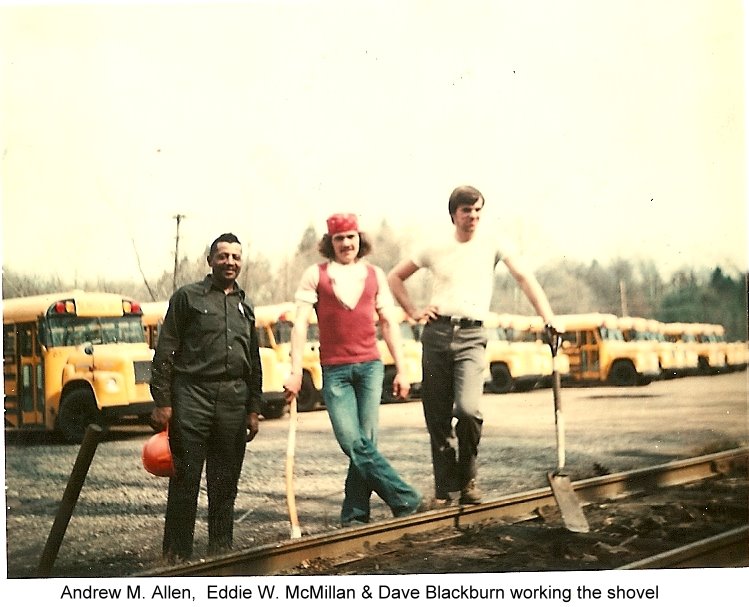
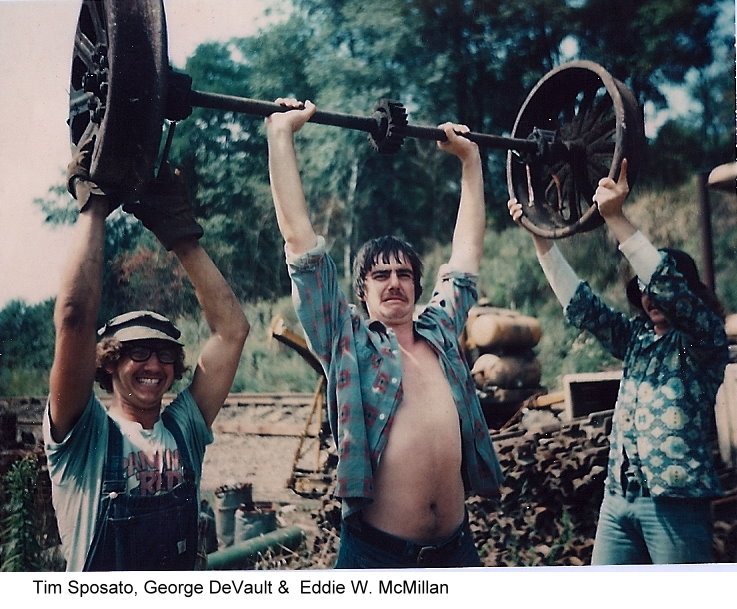
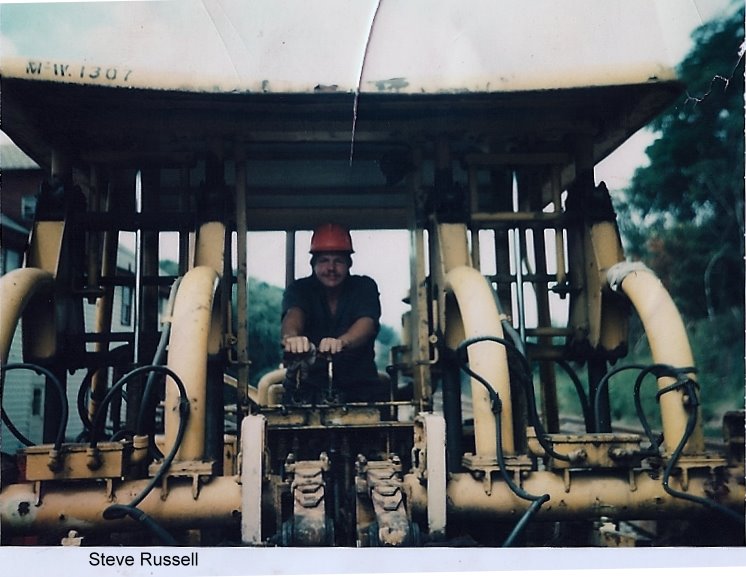
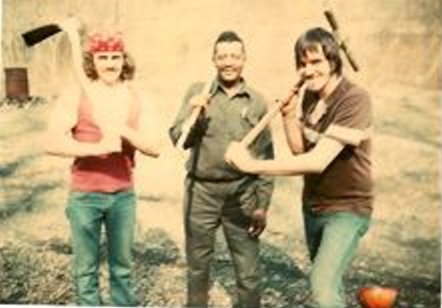
Eddie W. McMillan, Andrew M. Allen, George DeVault
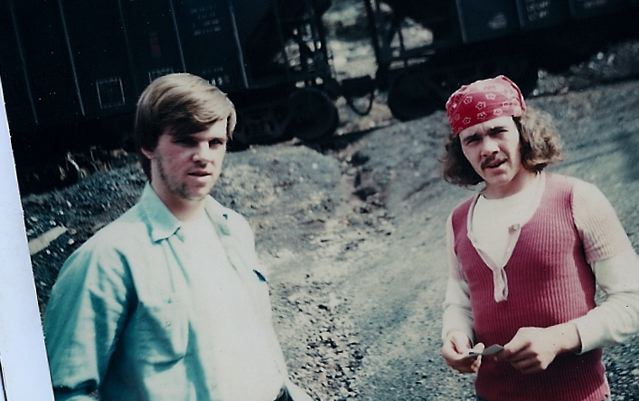
David . Blackburn & Eddie McMillan
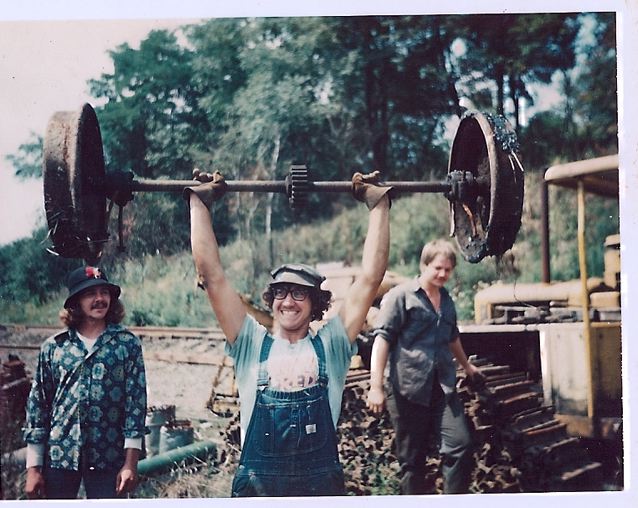
Eddied McMillan, Tim Sposato, Steve Russell
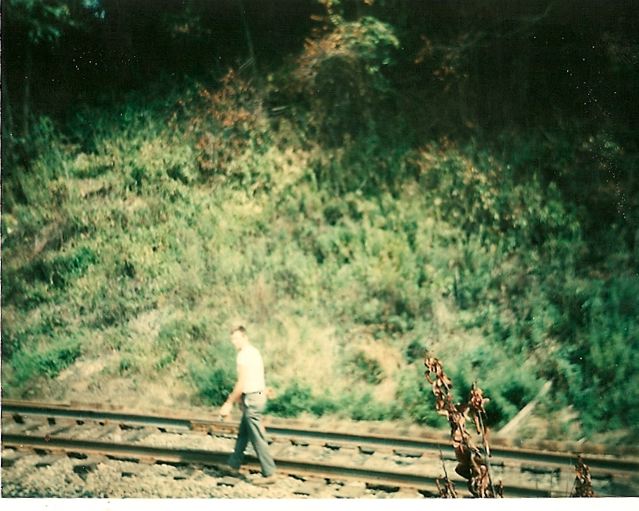
Dave Blackburn
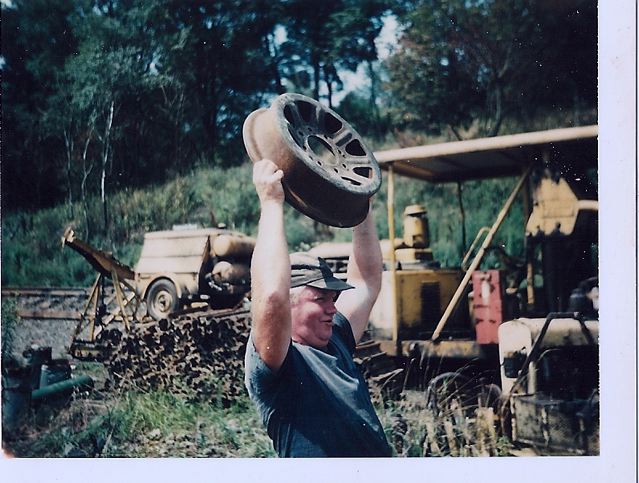
Cornilious J. Walker

Charles E. Williams (Pete)
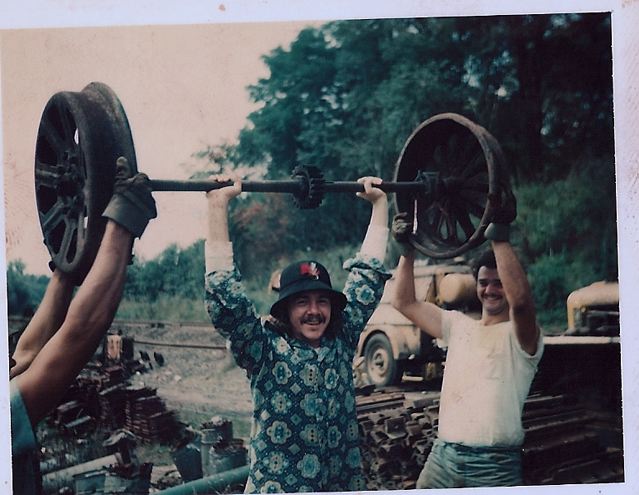
Eddie W. McMillan and James Beaver
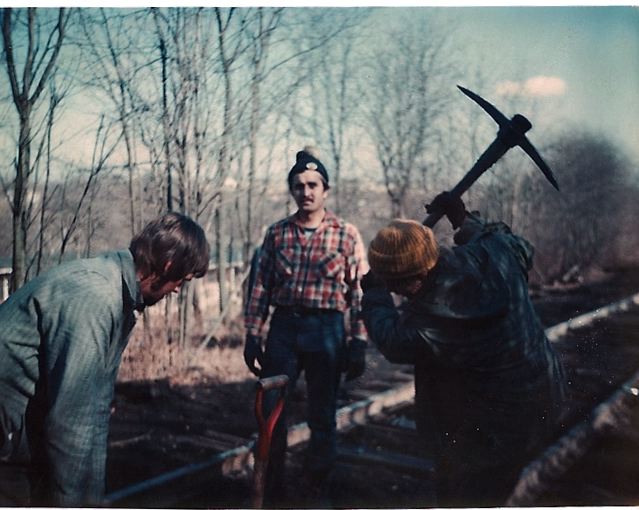
Mark E. Broskey December 76 (deceased cancer 1999)
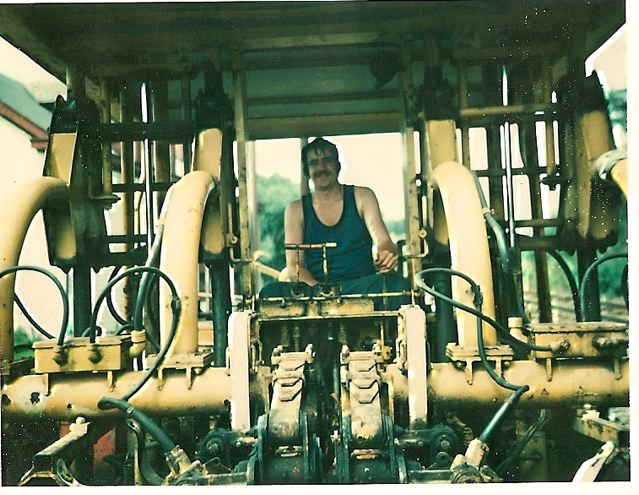
George DeVault
Comments by
Tim Sposato:
These
photographs show how the Montour was really about people. People that
had families to support, people that had bills to pay, people that
wanted to work, not collect welfare and assistance.
This group of Montour Men had fun, they worked hard when needed, long
hours at wrecks, cold wet nights, hot blistering summer days, both the
younger ones, side by side with the older ones, they worked as a family.
This was the last generation of Montour Men, some of us knew that but
dreamed it would continue, some didn't realize, but all had committed
to the effort to make it happen. These were all friends, I was present
at their weddings, parties, family gatherings, hunting trips, and more.
Mark Broskey, fresh from college, his career sidelined for the moment,
but tuition was due, the Montour helped him till that job opened up.
Now he's gone.
Pete
McMillan had his son Eddie (Capt. Neat) follow in his footsteps,
becoming the Extra Gang foreman. As you can see in the photos, he is
always 'neat'.
Pete Williams, a great friend, always stuck up for you, good guy to
have on your side. Full of fun.
Loved the women.....
Corneil Walker, been around for ever, father figure to many, also known
as the 'Grey Fox' or "Sly Fox'.
I can go on & on.
Most of these pictures were taken at Hendersonville spur, the one shows
the white of the company house to the left. The Jackson Jr. tamper was
a hand me down, retired from the P&LE, coupled behind it on the
cart was the air compressor used for the spike hammer.
Also seen is the boom on the ancient rail crane, behind the compressor,
used to pull lengths of rail from the six foot onto the tie plates. The
adzer can be seen too, this was used to cut the ties surface so the
newer, larger plates would have a flat base to sit on.
The rail was badly worn through Hendersonville and were being replaced
with some used rail from the P&LE. Look close and the stacks of
angle bars, plates, spikes and other components required for rail
change out can be seen.
Now that hand pump car axle, well that lied around Hendersonville as
long as I can remember. As usual Montour Men wanted to prove their
strength, guess we all were competing for the finals that day.
January 21,
1977 MofW Roster showed;
Section Gang Two: Stationed out of Hills
JP Schmidt Foreman
FW Aitken Car cleaner #4 mine dayshift
CJ Walker Truck Driver
WT Lockart Car Cleaner #4 mine nightshift
CE Williams Laborer
TJ Sposato Laborer
RJ Dengler Labor
Extra Gang Four Stationed out of Hills
EW McMillan Foreman
DC Blackburn Laborer
G Devault Laborer
AM Allen Laborer
ME Broskey Laborer
SJ Russel Laborer
Many of their faces are shown that wonderful summer day, thirty
years
have passed, several of those fine gentleman have also passed, but the
memory lives on through the pictures taken, a parking lot covers this
ground, some landmarks thankfully remain for those who wish to linger
for a bit, I will be the first to linger there next week, to reflect on
those happy times as we enjoyed our youth and each other.
The heart of the Montour RR is not always a picture of its locomotives
or passing coal trains.
|
|
|
|
 I am pretty sure that the designers
at EMD didn’t exactly have this in mind, but due to the handrails
mounted on the hood, the Montour’s road name was kept prominently
displayed. I am pretty sure that the designers
at EMD didn’t exactly have this in mind, but due to the handrails
mounted on the hood, the Montour’s road name was kept prominently
displayed.
As the crews would walk along the engine walkway, they would rub
against the side of the hood, keeping a strip of the side, about waist
to shoulder high, clean of dirt and coal dust. While wearing a winter
coat, this would happen even more. I don’t imagine that the wives of
these guys were all that happy about them literally wearing the Montour
home on their sleeves, though, when laundry day came around.
Compare this with the MP15’s or other locomotives with railings on the
outside of the walkways. These crews would tend to lean away from the
side of the hood, toward the railing, to avoid the dirt and heat.
So, by purchasing the SW’s, the Montour was making sure that its name
would always be kept clean and proudly displayed.
Bryan Seip |
|
|
|
|
|
|
|

Heres a picture made at West End Hills with Dave Sherwood, this was an early shot in 1973 as
the Coal Run was ready to place the first loaded cut on the main
against the hack. Dave is throwing the Loaded Yard Switch
prior to shoving back. Note the "Repco" radio in his
hand on this nice summer day. You can see a PRR
hopper sitting on the Transfer to the PRR, the phone shanty and wayside
poles still standing. The bridge and Kamps Cut is behind
me. Between the caboose and the hopper on the hillside is
where the steel water tank once stood for the steam engines, the
standpipe for this was to the right of the hack along the main. Gosh
those days were wonderful. Tim Sposato
|
|
|
|

|
|
|
|

One winter day in 1979, I had to report
to the Superintent at Montour Jct, prior to my shift at Champion yard
office. As luck would have it a Champion yard crew was on
duty and preparing to leave as a "caboose hop" just when I had finished
the meeting. Seeing that I had plenty of time before my
2:00pm shift, I quickly decided to follow the crew to
Champion.
I stopped at numerous locations for pictures or
just to listen to the single note airhorn sounding for the crossings. A
favorite spot over the years was to sit at McLaughlin
crossing, and allow the train to get along side of
the truck so I could pace it eastbound for about a quarter mile. his
particular day was no different, but as the engine rounded the curve as
I watched the side mirror, the sudden notion of shooting a
picture came to mind.
The #83 was on its last whistle blast, the
crossing directly behind my 77 GMC Jimmy, I fired this shot and dropped
the camera onto the seat and started rolling as the engine caught up to
me. The clanking rail joints sounding with the
rumble of the EMD in the lower throttle notch was music to the ears.
The usual good nature banter started as engineer
Jack Harvard and I hollered back in forth during the 15 mph
chase to North Star Jct. After this short run
the track is on a higher grade as the road to Champion from
here is on the opposite side of the valley until MP 13 as it enters the
Boggs cut. I arrived at the YO just as the Crew pulled in. Then it was
another typical day at the Coal Washer.
Note also the short piece of
90# rail, a repair of an early break at one time. These short
pieces were a common sight on the 90# rail through out the
system. One can also see the general track appearance in
regard to the ties and ballast condition.
I always enjoy looking at this shot, the only
one I ever did one using the mirror, but these
unique shots make them more special.
Tim Sposato
|
|

|
|
|
|
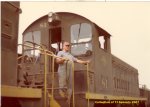
Here is a photo of Jim Lane taken
at Boggs yard on the main. They had just pulled
clean coal off the Siding at Champion and were air testing the train
for the trip to Montour Jct.
The recent posts of free use of Montour hauled
coal allows me to relate another human interest story about Jim Lane.
Jim was working as a fireman in late 1930's
on a run, late one winter evening out of Montour Jct,
he thought it might have been locomotive
#33.
As they headed east they passed through Greer
Tunnel, over the PRR in the through truss bridge and around the left
hand curve. Here they exploded a track torpedo used for
signaling a obstruction ahead. They slowed down and caught
sight of a flagman giving them a stop signal with a red
lantern. After stopping the flagman said his train ahead of
them was having air trouble with a pick up off the PRR Transfer at
Hills, but expected they would be moving East shortly. The
flagman climbed aboard as the engineer (George Barefoot) eased down to
stop behind the flagman's caboose.
At this point they had stopped on a short
straight stretch east of Greers crossing above what later became the
water purification plant for #4 mine along Chartiers
Creek. This was also next to an old frame/ log dwelling
belonging to an old widow woman. Her husband was a
miner all his life, but had past away. I can only believe the
miner used to walk either the Montour, or PRR that
crossed the creek at this same point, to work every day.
Depending if he worked the tipple or
entered the mine at the supply yard along the PRR.
Well, Jim living in Hills station,
knowing all
his neighbors decided to toss some coal out from the tender into her
front yard. He said he had tossed coal as
he passed by
on moving trains before, usually a shovel full or two if he was quick
enough. After he supplied her yard he climbed down
into the
cab and was confronted by the trainmaster. Seems the
TM had
been lurking around the train stopped in front of them and walked back
for a visit. He asked Jim what he had be
doing on the
tender and Jim replied he was shoving coal closer to the bunker doors
and trimming the loose coal so as not to have it fall from the top of
the tender. Well the trainmaster knew the real story and
wondered
why he saw coal landing in the widow's yard, no reply from
Jim
would have changed the verdict.
The TM reported Jim and disiplinary actions
where given in terms of more "brownies" to his record, but
the coal remained for the widow. Guess the TM may have had a soft spot
himself. I easily imagine the scene of the #33
sitting there shrouded in steam on a cold evening
with its headlight illuminating a wooden caboose and the silhouette of
Jim against the night sky making sure the old widow woman
would be warm for another night.
As you walk east today from Greers Crossing when
the foliage is dead you will be able to see the remnants of the old
dwelling foundation of the widow's home on the right side of
the grade.
I have stood there ,
looking around, listening, recalling of this story...........
Tim Sposato
|
|
|

|
|
|
|
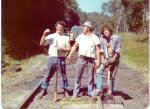
Summer of 1976, I have had about 15 months
employment by now when we started to safety tie sections of the
main between Hills and Library Jct.
Standard procedure was to spend a day or two
spreading new ties through a section, then coming back to install them.
Most work was done by manual labor, MRR was lean on the mechanized
equipment. We would load 30 ties on a push cart
and hi-rail to the drop points. The
foreman would be walking ahead with a yellow lumber crayon
and "X" the tie end to be replaced. The truck would
follow slowly as we walked next to the cart, one man on one
side, one on the other.
As we reached the bad tie, one man would snag a
new tie with his hands as the other
man gave it a push and this would "torpedo" the tie along the
six foot. This momentum would allow a man to carry the tie
clear of the cart.
This picture was take as we installed the new
ties and were tamping them with ballast & cinders against the
rail bottoms. The picture was taken east of Turkey farm
crossing and west of mile post #34 in Peters Twp.
The truck is the RH-2. The man on the left was Jim Beaver, John P
Schmidt, foreman in the center and Bobby Dengler on the
right. This was a portion of the Section Gang Two
based out of Hills Station.
I was a proud member of this gang at the time,
since this section covered the eastend by my home grounds. I
got the boys to line up for a couple of shots that day including
some of the tie distribution action and a shot of a younger
me posing with them. Guess I need to copy those to share
sometime.
Since that time, JP Schimdt was killed in a
construction accident, Bobby Dengler was killed in an automobile
accident, I last heard Jim Beaver was in jail.
Amazing how we never know what the future
holds......
Tim Sposato
|
|
|
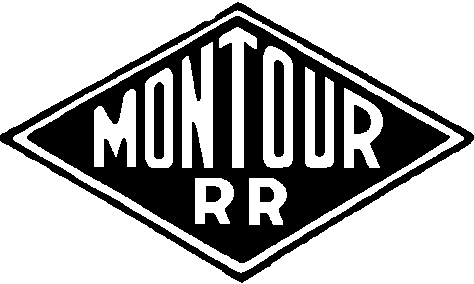 Montour Railroad
Montour Railroad 